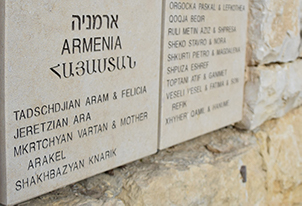02.02.2022

The stories of the genocides are full of tragedies and atrocities. Hundreds of thousands of people were involved in the murder process, becoming mass murderers.
However, at the same time, unparalleled examples of compassion and heroism are encountered, when certain individuals, risking their lives, saved their comrades, friends and even strangers who were targeted by the genocide.
Yad Vashem, the World Holocaust Remembrance Centre in Jerusalem commemorates the names of about 20,000 people who saved others. This is not a large number, considering that the number of people in the regions subject to the Holocaust reached several hundred million.
In 1953 the Israeli parliament - the Knesset - passed a law by which Yad Vashem, the memorial dedicated to the martyrs and heroes of the Jewish Holocaust, was built on one of the hills of the city of Jerusalem. Its aim was to commemorate the six million Jews killed by the Nazis and their allies during the Holocaust, to pay tribute to Jewish resistance fighters, as well as to “remember the high-minded gentiles who risked their lives to save Jews.”
The garden of the Righteous among the Nations was opened within the Yad Vashem complex on Holocaust Remembrance Day, 1962. This is where, even today, the righteous are honoured with trees being planted in their names.
In 1963 a committee was established, which included experts in the study of the Holocaust and chaired by a member of the Supreme Court of Justice of Israel, which formulated the criteria for determining who were righteous. They are:
1. Active involvement of the rescuer in saving one or several Jews from the threat of death or deportation to death camps
2. Risk to the rescuer’s life, liberty or position
3. The initial motivation being the intention to help persecuted Jews: i.e. not for payment or any other reward such as religious conversion of the saved person, adoption of a child, etc.
4. The existence of testimony of those who were helped or at least unequivocal documentation establishing the nature of the rescue and its circumstances.
After meeting these criteria, the righteous are awarded a specially struck medal and a certificate of honour – both bearing their name. Their name is then added to the Wall of Honour in the garden of the Righteous in Yad Vashem. The righteous living in Israel or their homelands are awarded by Israeli diplomatic representatives. The Righteous Among the Nations title is being granted to non-Jews.
This list of the righteous created by Yad Vashem includes people of different nationalities, religions and citizens of many countries. Armenia is the 25th country on that list. 26 of our compatriots have been awarded this honour. For most of them, the motivation to save lives was the memory of the Armenian Genocide. The bitter experience of their own people led them to aid others in a similar tragedy.
To appreciate the uniqueness of the acts carried out by the righteous, the circumstances under which they were performed must be remembered, with them endangering their own lives and those of their families. Both during the Armenian Genocide and during the Holocaust, severe punishments were imposed for aiding the victims which included the annihilation of the entire family.
The act of rescue is an exceptional feat, which shows that even in the terrible genocide conditions, it is possible to help the weak, the victims and those targeted. The righteous who assisted them overcame fear and indifference, came out against the most genocidal governments and society, becoming a standard of moral behaviour for future generations. They prove that it is possible and necessary to resist evil.
The list of Righteous Armenians:
1981 Jeredyan Ara
1982 Byurkjyan Yervand and Elbis
1992 Tashchyan Aram and Felitsya
1993 Ghukasyan Albert and Makruhi, and their daughter Bertan
1999 Mkrtchyan Vardan and his mother Arakel
1999 Shahbazyan Qnarik
2002 Tashchyan Grigor and Pran, and their children Hasmik and Tigran
2003 Keshishyan Harut and Zagoruqu Natalia and their daughter Almazan
2010 Hakobyan Ashkhen
2011 Dilsizyan Georg and their son Andre-Gustav
2013 Baghtasaryan Piruza and her son Sargis
2013 Khachatryan Harutyun
Dr. Suren Manukyan
Head of AGMI Vahagn Dadrian Comparative Genocide Studies Department





